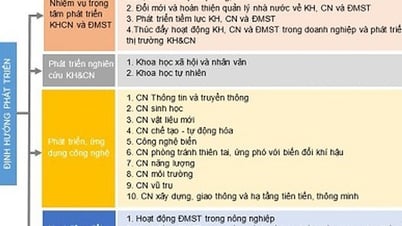Statistics show that 22-60% of heart attacks occur without typical symptoms such as chest pain or shortness of breath.
Medical news on January 4: Low blood pressure, is it a sign of myocardial infarction?
Statistics show that 22-60% of heart attacks occur without typical symptoms such as chest pain or shortness of breath.
Chest discomfort and low blood pressure, doctor discovers silent myocardial infarction
A 62-year-old male patient had no symptoms of chest pain or shortness of breath, nor was there any obvious sign of myocardial infarction in paraclinical tests. However, he was unexpectedly diagnosed with myocardial infarction with complete occlusion of the right coronary artery.
 |
| To prevent myocardial infarction, each person needs to maintain a healthy lifestyle: exercise regularly, eat scientifically , avoid smoking, maintain a reasonable body weight, and control underlying diseases such as high blood pressure and diabetes. Illustration photo |
Three days before being admitted to the hospital, the patient felt discomfort in the chest area, which only lasted a few seconds and then went away on its own. His blood pressure dropped slightly (100-110 mmHg compared to the normal level of 125 mmHg). He went to the provincial hospital for examination and had an electrocardiogram but no abnormalities were detected. The cardiac enzyme test also did not increase, the doctor diagnosed that it was stable and prescribed medication to take home.
However, two days later, his blood pressure suddenly dropped to 85/60 mmHg, although he had no symptoms of chest pain or dizziness. After self-monitoring, he was still not reassured and decided to go to the hospital for a check-up.
At the hospital, Dr. Vo Anh Minh, a cardiologist, noticed that the patient did not have typical signs of an acute myocardial infarction, such as chest pain, shortness of breath or sweating.
Although the electrocardiogram and cardiac enzymes show no abnormalities, minor symptoms such as chest discomfort and low blood pressure are warning signs of a silent heart attack.
After coronary angiography, the doctor discovered that the patient's right coronary artery was completely blocked, leading to myocardial infarction and heart failure (heart contraction function was only 42%, instead of the normal level of over 50%). If not detected in time, the damage to the heart muscle can increase severely and be irreversible.
Dr. Minh said that the coronary artery must supply blood to the right atrium and ventricle, and when this artery is blocked, the right ventricle will fail, leading to low blood pressure and heart rhythm disturbances. Without early intervention, the patient is at risk of cardiac arrest and death at any time.
Mr. Tin was immediately treated with anticoagulants and underwent coronary intervention with a stent. After 45 minutes, the stent was placed in the right coronary artery, restoring blood flow to the heart, helping to increase blood pressure to 120/80 mmHg and eliminating chest discomfort. Post-intervention echocardiography showed that heart function had improved by 48%, and was expected to continue to recover in the near future.
Statistics show that 22-60% of myocardial infarctions occur without typical symptoms such as chest pain or shortness of breath. Some patients only have vague symptoms such as fatigue, back pain, indigestion... and are easily confused with other diseases.
Notably, paraclinical tests such as electrocardiogram and cardiac enzymes often do not detect abnormalities in cases of silent myocardial infarction. Therefore, delayed diagnosis can lead to dangerous complications such as arrhythmia, heart failure, or cardiac arrest.
Dr. Minh recommends that to prevent myocardial infarction, each person needs to maintain a healthy lifestyle: exercise regularly, eat scientifically, avoid smoking, maintain a reasonable body weight, and control underlying diseases such as high blood pressure and diabetes.
At the same time, it is necessary to master the typical and atypical symptoms of myocardial infarction to go to the hospital promptly when there are unusual signs.
When the body shows strange symptoms, people should not self-diagnose or wait for the symptoms to disappear, but should go to medical facilities for timely examination and treatment.
Congenital heart disease detected at age 40 through routine check-up
Ms. Man, 40 years old, did not have typical symptoms of cardiovascular disease but was diagnosed with atrial septal defect after going to the doctor because she often felt tired.
A month ago, Ms. Man felt tired sometimes, but the symptoms were only transient and went away when she rested. The symptoms were not clear and were not accompanied by any other signs, making her subjective. After going to a private clinic for examination, the ultrasound showed suspected pulmonary valve stenosis, the doctor advised her to go to the hospital for further examination.
At the hospital, Dr. Vu Nang Phuc, a cardiovascular specialist at Tam Anh General Hospital, said that through a transthoracic echocardiogram, Ms. Man was diagnosed with a second atrial septal defect, 23 mm in diameter, with right heart chamber dilatation and mild pulmonary hypertension, along with mild pulmonary valve regurgitation. For further evaluation, the doctor ordered a transesophageal echocardiogram.
A transesophageal echocardiogram uses ultrasound waves to create detailed images of the heart and blood vessels. This method provides clearer images because the esophagus is close to the heart chambers and is not obstructed by ribs and lungs.
Transesophageal ultrasound results showed an atrial septal defect measuring 26×19 mm, with a large dilated right heart chamber. Ms. Man had no typical symptoms but only felt tired occasionally. Doctor Phuc said that if the disease was not treated promptly, the dilated right heart chamber would become more and more serious, increasing the risk of arrhythmia and right heart failure.
After consultation, the doctors decided to close the atrial septal defect for Ms. Man to prevent dangerous complications. Before the procedure, the team re-evaluated all the echocardiographic images through the chest wall and esophagus to determine the exact size and location of the defect, from which to choose the appropriate size closure device (36 mm) to perform.
Normally, this method requires transesophageal ultrasound and general anesthesia, but with this patient, because of the clear ultrasound image before, the doctor decided to only need local anesthesia.
The medical team performed a right heart catheterization procedure, removed pulmonary hypertension, and then inserted the atrial septal defect occlusion device into the correct position in the heart.
After 25 minutes, the procedure was completed, the occlusion device was stable and the patient did not experience any complications. Ms. Man recovered quickly and was discharged the next day.
Atrial septal defect (6-10% of congenital heart disease) is a condition in which there is a hole between the two atria. This hole can be located in many different locations and is divided into 4 types, the most common is the second atrial septal defect like Ms. Man's case (accounting for 70%).
Many cases of atrial septal defect have no obvious symptoms, especially in children, which makes the disease go undetected. Some patients are even diagnosed in their 60s and 70s.
For small atrial septal defects (less than 3 mm), the disease can close on its own. However, large defects (over 8 mm) need to be treated by sealing the defect to prevent complications such as heart failure, arrhythmia or stroke.
After atrial septal defect occlusion, the patient will need to rest and avoid strenuous physical activity for at least one month. The patient will also be prescribed medication for 3-6 months and will need to take endocarditis prophylaxis for 6 months. Regular follow-up visits to monitor the recovery and check the occlusion device are very important.
Dr. Phuc advises people not to be subjective with vague symptoms such as fatigue, mild shortness of breath or chest discomfort. If there are any unclear symptoms, they should go to the hospital for a thorough examination to avoid the disease progressing seriously without being detected in time.
Escape stroke thanks to obesity examination and treatment
Mr. Nghia (50 years old) was hospitalized urgently due to severe chest pain. After being consulted and diagnosed by doctors, he promptly underwent coronary stent placement, escaping the risk of a heart stroke.
At the hospital, doctors noted that Mr. Nghia had signs of chest pain unrelated to physical activity. Although the initial assessment was not too dangerous, the treatment records at Tam Anh Weight Loss Center showed that he had many risk factors for stroke, especially grade II obesity (BMI 34.53), along with lipid metabolism disorders.
Coronary angiography showed severe narrowing of the two main coronary arteries (80-90%), along with some other arteries with mild atherosclerosis. Chest pain is an early warning sign of a lack of blood and oxygen to the heart, which can lead to a heart attack (heart attack). Therefore, the doctor ordered Mr. Nghia to undergo a coronary stent procedure to prevent the risk of stroke.
Dr. Le Ba Ngoc, who directly treated the patient, noticed that Mr. Nghia had a high BMI, a lot of belly fat and neck fat, a history of smoking and a family history of heart stroke. Dr. Ngoc advised a coronary CT scan and discovered a serious coronary artery blockage.
Initially, Mr. Nghia refused to undergo further tests because he believed he was healthy, despite his high blood lipid test. However, after being counseled about the risk of stroke, Mr. Nghia agreed to undergo weight loss treatment and began the treatment regimen. After 2 weeks, he lost 2 kg, but chest pain occurred later, and he immediately underwent coronary intervention.
Immediately after stent placement, Mr. Nghia was monitored by doctors and supported to lose weight through diet, exercise, and visceral fat control.
After 2 days of monitoring, he was discharged from the hospital in good health and continued to maintain his weight loss regimen. By the 3rd week, he had lost 4 kg and expected to lose another 10% of his total weight in 3 months to reduce the risk of complications due to obesity.
Obesity not only affects appearance but is also related to a series of diseases such as diabetes, cardiovascular disease, metabolic disorders... However, these complications often develop silently, causing many people to be subjective like in the case of Mr. Nghia.
Dr. Ngoc emphasized that, in addition to BMI, visceral fat index is a factor that determines the risk of cardiovascular disease, diabetes and other metabolic disorders. Visceral fat index is proportional to waist circumference; if a man's waist circumference is over 94 cm and a woman's waist circumference is over 80 cm, the risk of disease will increase significantly.
According to Dr. Ngoc, weight loss is an effective way to prevent health complications caused by obesity. However, this process requires perseverance and time, especially for patients with underlying diseases or high visceral fat.
Besides diet and exercise, there are now weight loss treatments such as supportive drugs and fat freezing technology. However, patients need to consult a doctor to choose the most suitable method.
Source: https://baodautu.vn/tin-moi-y-te-ngay-41-tut-huyet-ap-co-phai-dau-hieu-nhoi-mau-co-tim-d238448.html





























































































Comment (0)